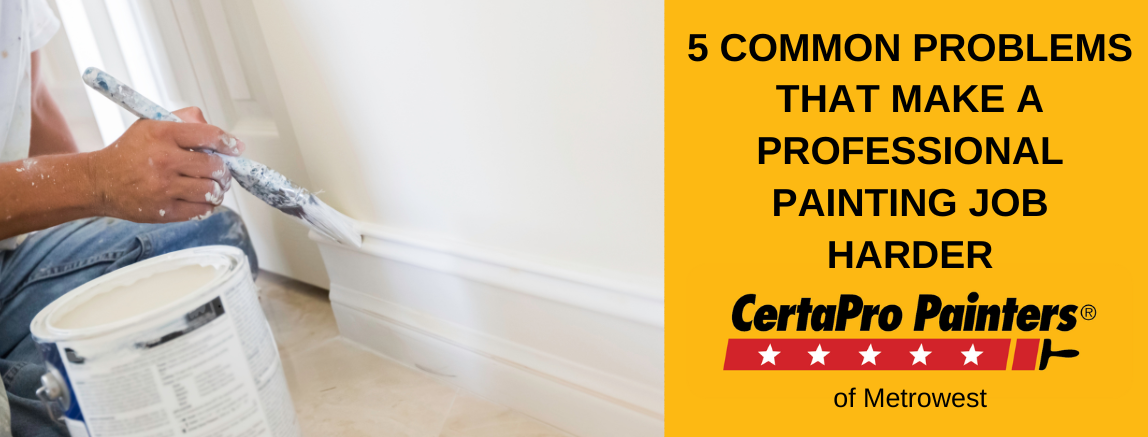
5 Common Problems that Make a Professional Painting Job Harder
Posted on October 4, 2023
Every professional painting job is a little bit different, and numerous factors determine the ease, speed, and overall efficiency of a painting crew’s work. Some of these factors are outside of everyone’s control (like tight spaces, weather damage, and so on), but other setbacks can be easily avoided if you know what to watch out for.
Let’s take a look at 5 common client mistakes that make a professional painting job more difficult, adding more work, more time, and more cost to an otherwise straightforward project.
1.Damaging Drywall During Wallpaper Removal
In preparation for a professional painting company, some clients remove wallpaper without taking the proper steps to protect the drywall underneath. Instead of using a glue dissolving solution or a steamer, they simply tear away the wallpaper – and in doing so, damage the surface of the drywall behind it. If the protective, papery top layer of the drywall is damaged, it needs to be repaired before it can be painted.
This means patches and sanding, or in more extreme cases, an entire skim coat before primer and paint can be applied. To avoid this extra work and delay to the actual painting, be extra careful when removing wallpaper. Use a steamer, a water/vinegar solution, or premade stripping liquid to dissolve the glue, score and remove sections with a putty knife, and exercise plenty of patience along the way to keep your drywall from being damaged.
2.Using the Wrong Primer
Part of the professional painting world involves fixing, redoing, or completing projects begun by clients. For one reason or another, the DIY approach didn’t work out, and the client hires a professional to bring their expertise to the incomplete or dissatisfying project.
One such example is using the wrong primer when attempting to paint stained trim or door frames. With the wrong primer, paint won’t properly adhere to stained surfaces, resulting in unsightly peeling, poor coverage, and other issues. While a professional painting company can certainly rectify the problem, all of the necessary sanding is time consuming and costly. To avoid this problem, choose your primer carefully – or leave stained surfaces to the pros.
3.Adhesive on the Ceiling
This one might sound a bit strange, but with recent products on the market, we’re seeing this issue more and more. Items like fun flashing lights for kids’ rooms, rope lights, and other adhesive-backed decorations are great fun, but the adhesive can damage paint when removed from the wall. In some cases, homeowners place these kinds of decorations right where the wall and ceiling meet, inadvertently getting that potentially damaging adhesive on both the wall and the ceiling.
This isn’t an issue if you’re already planning on painting the ceiling… But if repainting the ceiling wasn’t already part of your plan, it’s a hefty, time-consuming addition that requires covering furniture, moving items, and that much more paint.
To avoid the issue, pay attention to where you stick things on the wall – and keep a good buffer between the seam of the wall and ceiling to prevent unplanned, unnecessary damage to the ceiling’s paint!
4.Painting Deck Floors
As a rule of thumb, decks should always be stained, not painted. Because deck floorboards are exposed to the elements, and have rain and snow sitting right on top of them, moisture will inevitably get under the paint and cause cracking… And look terrible. Paint also won’t effectively protect the wood nearly as well as a penetrating stain.
Because stain needs to soak into the wood to do its job, simply staining over the paint won’t work. The entire deck will need grinding and sanding to fully remove the paint before staining, which is considerably time consuming.
The only way to avoid this problem is to not paint your deck floor in the first place, and be wary of any “professional” painter who suggests this approach.
5.Mismatched Touch Ups
Last but not least, some clients don’t understand the subtle differences in paint color and sheen, and may try to use similar – but not exactly matching – paint for touch ups. The results are an eyesore, and require a painting company to go to great lengths to identify each mismatched touch up for spot-painting, or repaint the entire surface. Both take unnecessary time.
Don’t try to do touch ups unless you’re sure you have an EXACT match for your paint, and beware that even the same high sheen paint can leave lines when you do touch ups. For glossy paint touch ups, it’s often better to consult a professional before taking any action.
Keep these common mistakes in mind as you tackle DIY projects, plan for future painting endeavors, and update decor. Knowing these pitfalls could lead to big savings and faster turnaround when it’s time to hire a professional painting company.
If you have any questions about these topics, or anything else related to your home’s interior and exterior paint needs, contact CertaPro today!





